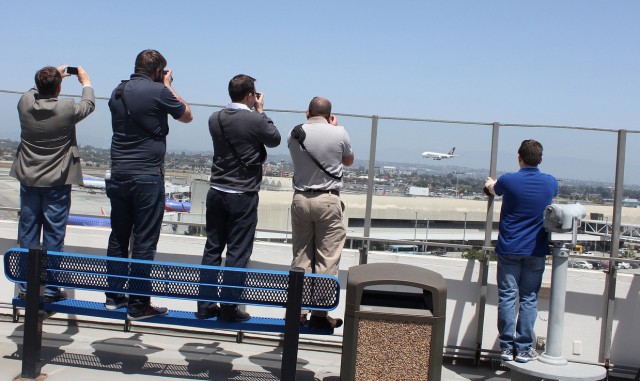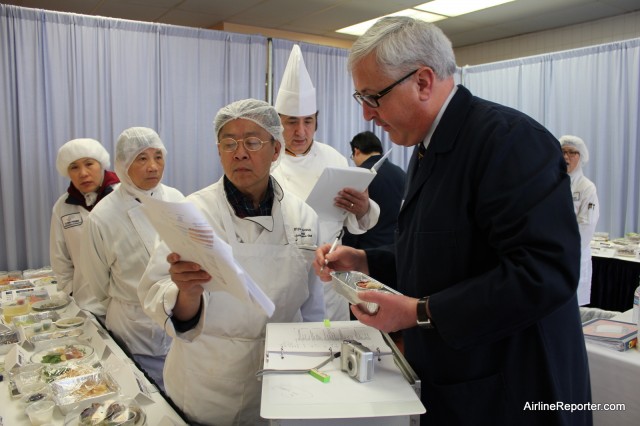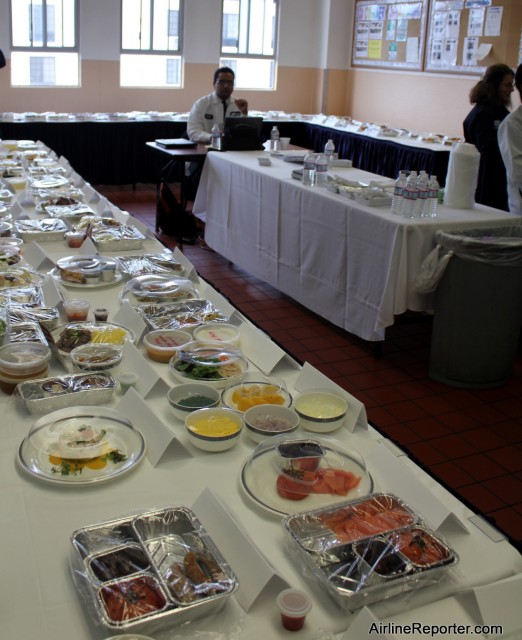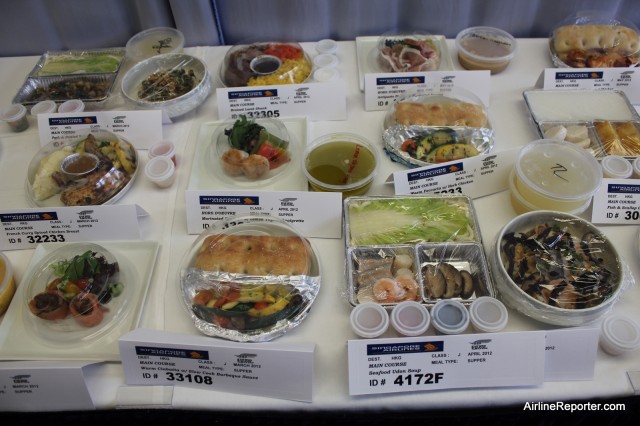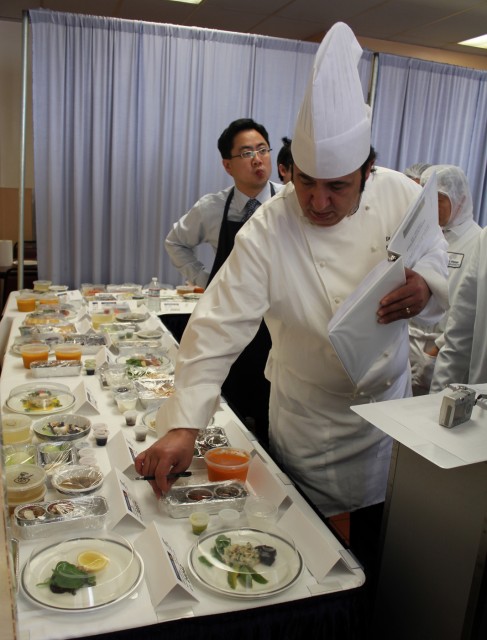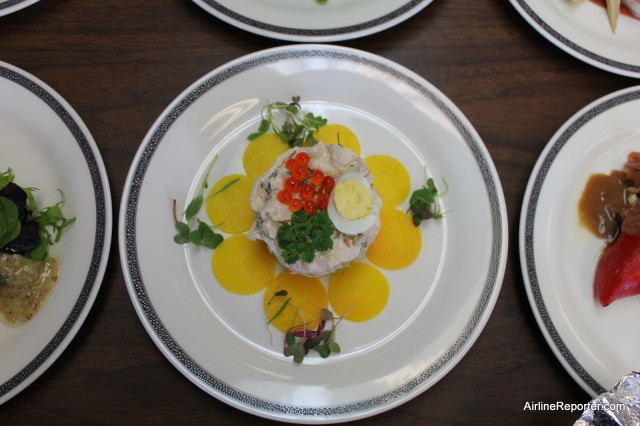This video, by SpeedbirdHD, highlights multiple Airbus A380s landing at Los Angeles International Airport (LAX). The video shows Qantas, Air France, Singapore Airlines, Korean Air and China Southern all touching down. So which one landed the best?
Browsing Tag: Singapore Airlines
When Singapore Airlines came to me and pitched doing something with a small group of AvGeeks at LAX to watch their Airbus A380 land and depart, I was instantly interested and with almost no details said, “yes please.”
Almost five years ago, when I started AirlineReporter.com, I had a hard time defining this passion that I had for airlines and aviation. Once I gained some readers and was able to start defining who we all are (we are AvGeeks), very few airlines got it.
I don’t blame them. It is hard to get how to interact with this group of people that dedicate a large portion of their lives with airliners. Either researching, looking at photos, taking their own photos, flying on them or in my case blogging on them. But we are a force and some airlines, like Singapore, are starting to get who we are — and they like us.
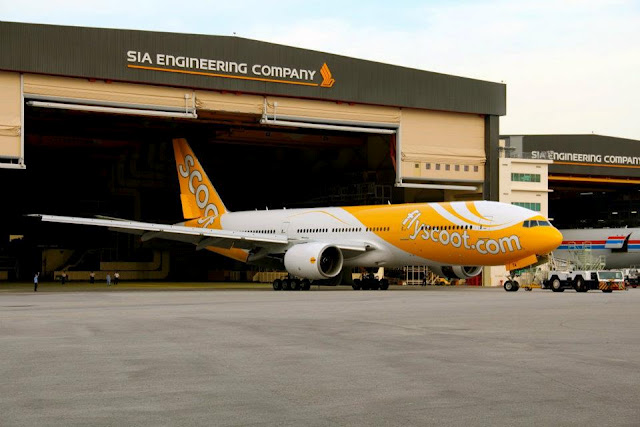
This ex-Singapore Airlines Boeing 777-200 (9V-OTA) is now painted in Scoot Airlines yellow livery. Image from Scoot.
This airline really has some Scootitude — that is their statement, not mine.
Scoot Airlines is a new low-cost airline that looks to start operations soon and is owned by parent company Singapore Airlines.
The airline currently has a fleet of two Boeing 777s, which previously flew for Singapore Airlines. The aircraft are configured in a 2-class layout with 32 ScootBiz seats in a 2-4-2 configuration and the rest in economy with a 3-4-3 configuration.
Scoot is initially planning routes from Singapore to Australia, China and Thailand. The first flight is planned for June 6, 2012 to Sydney and the rest in the following months.
This vibrant yellow livery on a Boeing 777-200 really stands out. I keep going back and forth on this one, trying to see if I like it. In some ways, I really enjoy the fact that a bright livery is on a 777, but in others, it just seems so weird, since we normally see “fun” liveries, only on smaller aircraft like the 737. What do you think?
For more images of Scoot’s livery, check out their FaceBook page.
When it comes to airline food, most people have a pretty low expectation of what they will receive. That expectation has lowered even further over the past few years with the almost-complete elimination of free airline food served on domestic flights within the United States. To find a decent airline meal, one needs to take an international flight. Typically, the amount you pay for a ticket will correlate with the level of meal you will receive. How does a world class airline go about providing multiple meals for up to 477 passengers on just one flight? I wasn’t sure, but when I was recently given the opportunity to check out how Singapore Airlines runs its food operation out of San Francisco (SFO), I could not refuse (note that my trip down and back were taken care of by Singapore Airlines and JetSuite).
Checking out Singapore Airlines makes sense. For them, food is not just something they give to passengers to make sure they don’t go hungry; they see it as part of the in-flight service. It is an experience both via taste/sight and a positive interaction with the flight crew. How does an airline prepare a meal for someone who has spent $5000.00 or even $20,000.00 on a ticket and are used to the best things in life? Well, it is not easy, nor cheap. Each year, Singapore Airlines spends about $500,000,000.00 just on their food service alone — that is quite the investment.
At each main Singapore Airlines hub in the US, it selects a caterer to produce the food. At SFO, it uses Flying Food Group, which also provides airline catering for a number of other airlines, even though all of Singapore’s recipes are unique.
Frequent fliers on Singapore do not want to see the same food week after week, so the airline needs to keep the selection new. Because of this, Singapore Airlines changes most of its entire menu each quarter. Hidden away in Singapore Airlines headquarters is a list of all the food that will be served in the coming quarters. The menu is not just a broad, “we will serve chicken and salad,” but a list that is extremely detailed, down to the exact last gram of everything, how many nuts will be on that salad and how much the entire meal will weigh.
There is no down time when it comes to the food. Just after the previous quarter’s food goes live, Singapore sends the next quarter’s menu to the Flying Food Group, so that they can start preparations for following quarter. Their chefs work on successfully creating the new menu and once they have all the food from each of the three classes completed, they invite Singapore Airlines in for a Menu Presentation to visually inspect each and every item and then taste test the food — this is where my visit comes in.
After landing at SFO, I was driven to the Flying Food Group building, located just down the street from the airport. The building is not the most beautiful on the outside, but it is more about what is on the inside. After being checked in, I put on an official food tester garb and was taken to a back room, which had hundreds of different food options on display. Representatives from both the Flying Air Group and Singapore Airlines went item by item, going over every aspect of each main dish, side dish, sauces and the plate layout.
Once the food is agreed upon, photos are taken that will be placed on the aircraft, so that flight attendants will know what the final serving should look like. But before anything can be finalized, the food needs to be tasted. It is a rough life, but to be able to write the best story possible, I decided I should probably try some of the food.
We were escorted to another room, where samples of the food were being served. From the soups to salads, to main entrees, I have to say that they were good — really good. During the sampling it was determined that one of the soups was a bit too spicy and Singapore requested that it be toned down a bit and the caterer agreed.
Making quality food at a restaurant on the ground is difficult enough as it is. Creating a meal, that will not be eaten for another ten hours and it still needs to taste world class is a whole other level. One question is how much should the caterer cook the food vs how much does it get cooked on the plane? For example, chicken will be cooked about 60% on the ground and the rest in the air, where steak will only be cooked 30% before being loaded onto a plane.
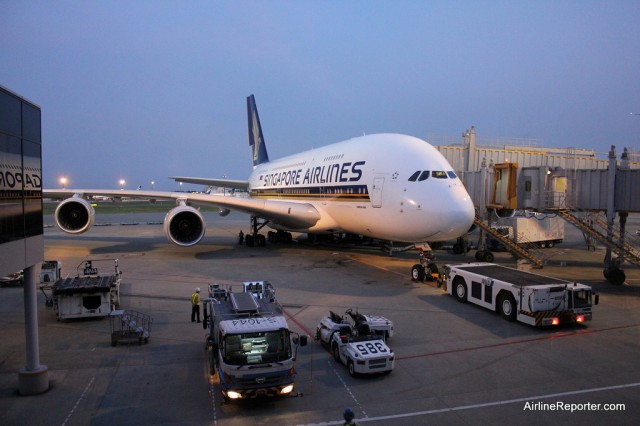
Singapore Airlines Airbus A380 can hold 471 people. Times that by multiple meals and things can get challenging. This A380 is seen waiting at Narita in Tokyo.
No matter what level the food is cooked, once it is ready, it is “blast chilled.” Now, do not call this “freezing” the food — I got the feeling that calling it that is borderline insulting. In the blast-chilled process, the food is taken to just above freezing very quickly, but doesn’t cause all the damage at the cellular level that freezing does. The food is then loaded onto carts, then to a truck, then off to the airport to be loaded onto the aircraft. It is an impressive ballet of trying to time things just right so the food does not go too long before being consumed.
Delays in the airline business are inevitable. While passengers begin to stress about arriving late, there are people who are thinking about the food. If a delay pops up early enough, the food’s preparation is held off until later. If the food is already made, it will be stored in a freezer at the caterer. The worse case scenario, if a flight is delayed after the food has already been loaded onto the aircraft, there are times, where the call is made to dump the current food and have the caterer bring over a fresh supply. It is a costly waste, but better than passengers getting sub-par food or worse, sick.
It is difficult, but having to destroy food is part of the airline catering business. At the end of each flight, there will always be left over food. Either from passengers who didn’t finish their entire meal or for whole carts of food that were never used. Due to international regulations, all food that returns to the US on an international flight needs to be destroyed. The carts are loaded back onto the caterer’s trucks, taken to the facility and placed into a huge oven before being disposed of. This is to assure that there are no food-borne bugs that could cause an international incident.
Serving the same quality of food in economy as you do in first class could also cause some sort of incident — folks who pay more, expect a higher level of food. First class meals are prepared using three different types of ovens: steam, convection and microwave. Each item is individually cooked before being served to the customer. Economy food is made to be more efficient and less time consuming. If you order scramble eggs as a First Class passenger, they will break open real eggs while in-flight and prepare them right there on the plane for you. However, if you are seated more towards the back, you are getting pre-prepared eggs from the ground.
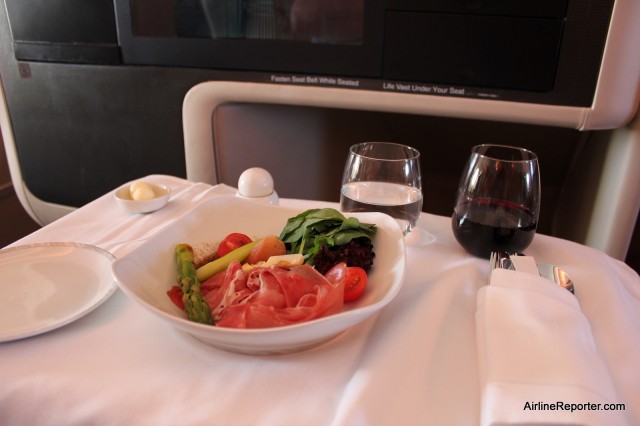
And then, the meal ends up on the plane. This photo is from 2010 on Singapore Airlines A380 Business Class.
What amazed me the most about this was how much process, time, energy and money is involved to get food to passengers. The crazy thing is this is only for SFO flights, (there are only three: Seoul, Hong Kong and Singapore) and each of these steps are repeated around the world.
If you get bored of the Singapore menu before the quarter runs out, you also have the options Book the Cook program, which allows you to order a custom meal.
I have had the opportunity to fly on Singapore Airlines A380 previously, and I had no idea the work and preparation that went into my food. Airline food might never be the same for me. I am always going to think about how the meal was planned, cooked and the detailed process it experienced before reaching my palate.
“If it bleeds it leads” — a nice classic saying of writing sensational stories to get more traffic.
When I first heard of small cracks being found on Qantas and Singapore Airlines A380s I read up on it and found it to be a non-issue and not really worthy of writing a story. The majority of media covered it the way that they should — that cracks were found and they are no big deal. Some examples:
Toronto Star by Lesley Ciarula Taylor:
‘Non-critical’ cracks inside wings of Airbus A380 spark grounding call
ATWOnline by Geoffrey Thomas:
Minor cracks found in Qantas A380 wings pose no safety threat
Reuters by Harry Suhartono and Narayanan Somasundaram:
Singapore Air, Qantas say cracks found in Airbus A380 wings
USA Today by Ben Mutzabaugh:
Cracks found on A380 wing parts called ‘non-critical’
Then I start seeing more and more sensational headlines that were very misleading and it started to frustrate me. They acted like planes were going to start falling out of the sky and everyone needs to panic. Some of those examples:
Daily Mail by Rob Waugh:
World’s biggest super-jumbos must be GROUNDED, say engineers after cracks are found in the wings of three Airbus A380s
– Wow, even capitalizing the word “grounded” — classy.
CNET by Edward Moyer:
World’s largest passenger plane may be unsafe, some say
– I love the “some say,” it doesn’t really matter who, just some people are saying it and we are reporting it.
Gizmodo by Jamie Condliffe:
Airbus Refuses To Ground A380s Despite Cracks In Their Wings
– Or, they might refuse to ground them, because they do not need to be grounded.
BBC News by Tim Allman:
Airbus A380 fleet should be grounded, say engineers
– Well if engineers are saying it, then it has to be true.
What interests me is that those “some say,” and “engineers” all turn out to be the same one person in all these stories…
“We can’t continue to gamble with people’s lives and hope they make it until their four-year inspection,’ said Steve Purvinas, federal secretary for the Australian Licensed Aircraft Engineers Association.
What almost all the news sources do not say is that Purvinas’ organization has been fighting against Qantas’ decision to outsource maintenance jobs. Interesting huh? It would seem to me that this guy and the ALAEA might have an agenda.
Safeskies (an organization specializes in airline safety) chairman David Forsyth stated that, “I doubt the ALAEA union which made the comments, is technically trained or qualified to argue against Airbus structural design engineers about cracks in their aircraft. Airbus will investigate these cracks and promulgate an inspection program, agreed by the safety Regulators.” He continued with, “Using safety as a weapon in IR disputes, without reasonable grounds, is like the boy who cried wolf. Repeated ad nauseam, the impact will lessen over time, and if eventually there is a valid safety issue, it might be dismissed as just another rant.”
Airbus has confirmed the cracks, but stated that they are not a safety issue. “We have traced the origin to a material-related manufacturing issue and developed an inspection and repair procedure which will be done during routine, scheduled, maintenance checks. This is not a safety issue. Aircraft performance is not affected. Any fix, if necessary, can be done during regular (4 year) maintenance.”
Every single airliner ever build has had issues that do not affect safety. Aircraft manufactures issue thousands of service bulletins and the huge majority of them are very minor.
This really is a non-story that should have never received much coverage outside airline trade journals. Yet, it was too tempting for some journalists and their editors to write that an engineer stated that the fleet of A380s should be grounded. The airline business is a disproportionately mis-represented business already and stories like this do not help the situation.
